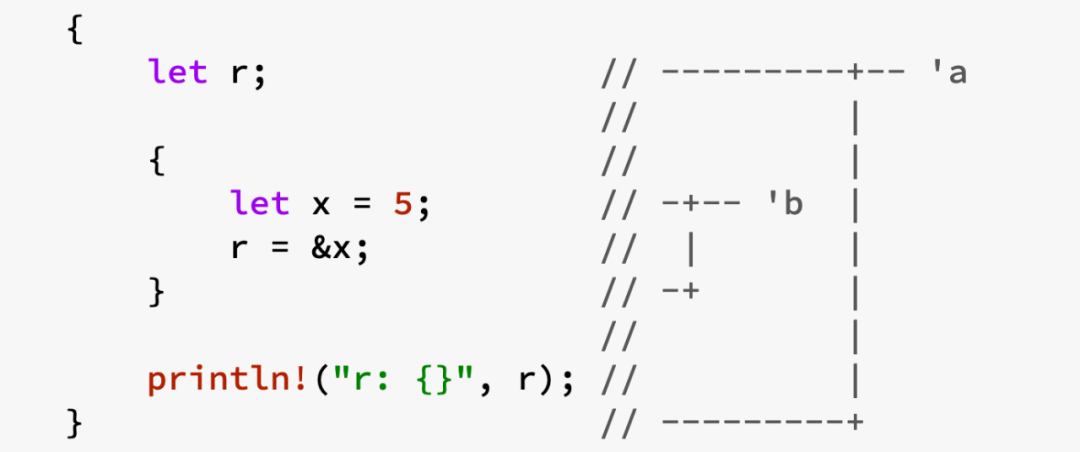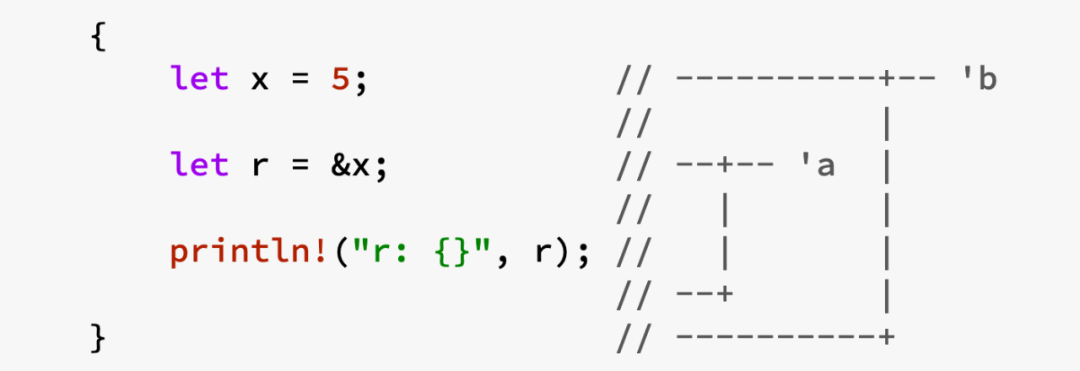Rust 让人难以理解的 lifetime
首先什么是 lifetimes? 生命周期定义了一个引用的有效范围,换句话说 lifetimes 是编译器用来比对 owner 和 borrower 存活时间的工具,目的是尽可能的避免悬垂引用(dangling pointer)
fn main() {
{
let r;
{
let x = 5;
r = &x;
// ^^ borrowed value does not live long enough
}
// - `x` dropped here while still borrowed
println!("r: {}", r);
// - borrow later used here
}
}let r; 声明了一个变量,在内层语句块中变成对 x 变量的引用,当内层语句块结束后,变量 x (owner) 脱离作用域释放,println 时 r 成了悬垂引用,所以编译器报错
借用检查器
借用检查器 (borrow checker) 用来对比作用域,来决定这个引用是否有效。上图有两个注释 'a``'b 来分别代表 r, x 的作用域,内存语句块的 'b 远远小于外层的 'a, 编译阶段发现 x 生命周期短于 r, 所以报错阻止编译
如果要修复也很简单,把 println 放到内层语句块即可。大多数时候,我们不需要显示指定 lifetimes, 编译器很智能,会自动帮我们推断,但也有例外
看个例子
fn main() {
let string1 = String::from("abcd");
let string2 = "xyz";
let result = longest(string1.as_str(), string2);
println!("The longest string is {}", result);
}
fn longest(x: &str, y: &str) -> &str {
if x.len() > y.len() {
x
} else {
y
}
}来看一个需要指定 lifetimes 的例子,longest 返回字符串最长的引用,编译时报错
编译器蒙逼了,他不知道函数返回的引用到底是哪一个,需要指定生命周期。并且很贴心的给了提示
fn longest<'a>(x: &'a str, y: &'a str) -> &'a str
这里引出 lifetimes 的一个规则:如果函数输入参数有引用(凡是引用必然有 lifetimes), 返回结果如果不是引用,那么可以省略标注生命周期,反之必须标注
道理很简单,如果返回结果是引用,那么根据 ownership 的三原则,他引用的对象一定不是函数内部创建的,因为函数返回后,该引用的对象会被释放掉,返回的引用就成了悬垂引用
所以,返回引用的生命周期必然和输入参数的一致,这就引出 lifetimes 第二个规则:如果输入参数只有一个是引用,带有 lifetimes, 且返回值也是引用,那么这两个生命周期必然一致,可以省略标注 lifetimes, 反之必须标注
这里稍微有些绕,大家需要仔细想想并且多跑跑测试例子,加深理解,我刚开始接触这里也走了很多弯路
生命周期语法
&i32 // a reference
&'a i32 // a reference with an explicit lifetime
&'a mut i32 // a mutable reference with an explicit lifetime语法没什么特别的,就是泛型语法,通常从 'a 开始,'b, 'c 都行,写成别的也可以
fn longest<'a>(x: &'a str, y: &'a str) -> &'a str {
if x.len() > y.len() {
x
} else {
y
}
}上面的例子 <'a> 是泛型语法,函数签名表示 x, y 生命周期是一样的,那么返回引用自然也是 'a
fn main() {
let s: &'static str = "I have a static lifetime.";
}但是上面的静态生命周期的要用 'static 关键字,表示该引用存活在整个程序运行期间。该字符串会被编译到二进制 data 数据段中
fn longest_with_an_announcement<'a, T>(x: &'a str, y: &'a str, ann: T) -> &'a str
where T: Display
{
println!("Announcement! {}", ann);
if x.len() > y.len() {
x
} else {
y
}
}上面是和正常泛型参数结合的例子,<'a, T>, 第一个 'a 是生命周期,第二个是泛型 T, 要求实现 Display trait. 注意这里面顺序不能颠倒,如果 T 放到前面会报错
error: lifetime parameters must be declared prior to type parameters
--> src/main.rs:6:36
|
6 | fn longest_with_an_announcement<T, 'a>(x: &'a str, y: &'a str, ann: T) -> &'a str
| ----^^- help: reorder the parameters: lifetimes, then types: `<'a, T>`
error: aborting due to previous error函数签名里的标注
fn main() {
let string1 = String::from("long string is long");
let result;
{
let string2 = String::from("xyz");
result = longest(string1.as_str(), string2.as_str());
}
println!("The longest string is {}", result);
}
fn longest<'a>(x: &'a str, y: &'a str) -> &'a str {
if x.len() > y.len() {
x
} else {
y
}
}
这个例子就会报错,虽然我们指定了生命周期,但没什么用。string2 在语句块结束后就被释放了,println resut 时继续使用 string2 的引用就是非法的。把 println 放在语句块内部就可以了
多个生命周期参数
fn longest<'a, 'b>(x: &'a str, y: &'b str) -> &'a str
如果函数有多个生命周期参数,'a, 'b, 返回引用是 'a, 此时编译会报错
11 | fn longest<'a, 'b>(x: &'a str, y: &'b str) -> &'a str {
| ------- -------
| |
| this parameter and the return type are declared with different lifetimes...
...
15 | y
| ^ ...but data from `y` is returned here原理很简单,编译器无法确定这两个 lifetimes 的有效长度,需要指定约束
fn longest<'a, 'b: 'a>(x: &'a str, y: &'b str) -> &'a str {
if x.len() > y.len() {
x
} else {
y
}
}最终函数如上所示,其中 'b: 'a 表示 'b 一定包括 'a 生命周期长度
结构体内的标注
struct ImportantExcerpt<'a> {
part: &'a str,
}
fn main() {
let novel = String::from("Call me Ishmael. Some years ago...");
let first_sentence = novel.split('.')
.next()
.expect("Could not find a '.'");
let i = ImportantExcerpt { part: first_sentence };
}在结构体定义时,如果存在引用,也要写上 'a 注释,泛型语法这里不再赘述了。part 是一个字符串引用,在实例 i 创建前就存在了,并且和 i 同时离开作用域被释放
如果去掉泛型的 lifetime 注释,就会报错
error[E0106]: missing lifetime specifier
--> src/main.rs:2:11
|
2 | part: & str,
| ^ expected named lifetime parameter
|
help: consider introducing a named lifetime parameter结构体方法的标注
struct ImportantExcerpt<'a> {
part: &'a str,
}
impl<'a> ImportantExcerpt<'a> {
fn announce_and_return_part(&self, announcement: &str) -> &str {
println!("Attention please: {}", announcement);
self.part
}
}结构体方法的标注语法要在 impl 关键字后写上 <'a>, 并在结构体名后使用。这个例子中并没有在 announce_and_return_part 中标注,这里引出另一条规则 如果方法有多个输入生命周期参数并且其中一个参数是 &self 或 &mut self,说明是个对象的方法(method), 那么所有输出生命周期参数被赋予 self 的生命周期
假如把 announce_and_return_part 返回值换成 announcement 就会报错
9 | fn announce_and_return_part(&self, announcement: &str) -> &str {
| ---- ----
| |
|this parameter and the return type are declared with different lifetimes...
...
12 |announcement
| ^^^^^^^^^^^^ ...but data from `announcement` is returned here这时需要显示的指定来协助编译器来完成检查,指定 lifetime. 另外涉及子类型,协变,逆变时生命周期会更复杂一些,感兴趣的可以参考 nomicon[2] 官方文档
小结
杂七杂八写了一大堆,建议大家还是上手多练,多琢磨。以前刚学 rust 时,有人说编译不过的话,生命周期就加 ''a', 数据就多用 clone``
其实呢,还是要理解本质,和 Go GC 运行期遍历不同,检查器要在编译期确定资源何时何处释放,就需要收集额外的信息。比如说,结构对象有个引用字段。如果无法确认它的生命周期,那么结构对象释放时,是否要释放该字段?还是说该字段可以提前自动释放,是否导致悬垂引用?显然,这违反了安全规则
再次强调,Rust 为了所谓的零运行时成本,把很多 GC 语言的工作放到了编译期
参考资料
[1]the rust book: https://doc.rust-lang.org/book/ch10-03-lifetime-syntax.html,
[2]subtyping-and-variance: https://doc.rust-lang.org/nomicon/subtyping.html#subtyping-and-variance,



